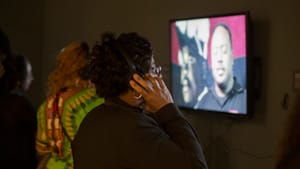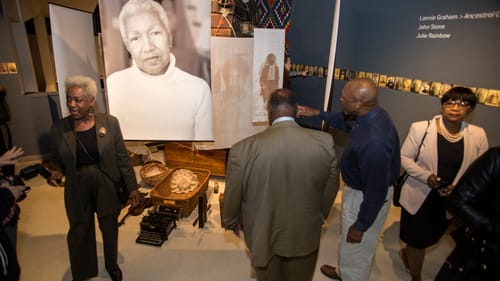Stay in the Loop
BSR publishes on a weekly schedule, with an email newsletter every Wednesday and Thursday morning. There’s no paywall, and subscribing is always free.
Creating a new home
African American Museum presents 'Tone Poems & Light Stories'

We can forget neither where we came from nor the people, places, and effects that helped us along on our journeys. This is the theme that reverberates throughout Tone Poems & Light Stories: The Great Migration at the African American Museum in Philadelphia (AAMP) .
In collaboration with Scribe Video Center, Tone Poems & Light Stories is an audiovisual, two-gallery exhibition commemorating several institutions critical in aiding black migrants from the South during the first wave of the Great Migration to Philadelphia, between 1916 and 1929.
Institutions such as the Philadelphia Tribune, America’s oldest and Philadelphia’s largest daily newspaper serving the African-American community, provided migrants with information about news, community events, and job opportunities, while religious organizations like Mother Bethel AME Church welcomed migrants and gave them a sense of belonging in the strange city they now called home.
The journey north
Historians project that more than 6 million African Americans left the rural South from 1916 to 1970 for cities in the North, West, and Midwest in search of factory jobs and to escape the violent racial discrimination plaguing the South. Their journeys were long and arduous. Many were denied access to gas stations or hotel rooms as they made their way to Philadelphia.
Through video presentations, Tone Poems & Light Stories successfully explores the difficulties blacks endured as they traveled north, but primarily emphasizes their determination to build a new life and become active members of their new communities.
I appreciated the video presentations -- the core of the exhibition -- because they showcased first-person recollections of how organizations such as the YMCA and the Universal Negro Improvement Association helped migrants establish roots, integrate into their new urban landscape, and feel empowered in their new home. Their ability to do this is a testament to the gumption and resiliency the migrants had to better themselves and the generations that followed. This seemed especially true for the single women who found refuge at the Ruth L. Bennett Place in Chester, Pennsylvania.
Finding a home
The piece, titled Finding Home: The Ruth L. Bennett Story, was one of several videos commissioned from Scribe’s Precious Places Community History Project.
Many female migrants had no connections and no place to stay when they arrived. Often they were forced to seek refuge at a police station as a last resort. Bennet, a pastor’s wife and local activist, took in women and their children until they secured jobs and housing of their own.

Bennett’s story resonated with me, because it sparked stories my Grammy Bea told me of her journey north from Meridian, Mississippi, to Philadelphia.
My Grammy settled in West Philadelphia in the 1940s when she was about 18 years old. She was part of a time historians call the “second wave” of the Great Migration, which continued until 1970. With a high-school diploma, Grammy was able to secure jobs in a shoe factory, as a crossing guard, and at the post office. She lived with her older sister until she married and moved into a home of her own, less than a mile away.
Products of the past
Pulitzer Prize-winning journalist and author Isabel Wilkerson once said that the stories of the Great Migration are not ancient history but living history, and that most people of color can find someone in their family who migrated and experienced the feelings of dislocation, longing, and fortitude prompted by this journey. Tone Poems & Light Stories invites observers to appreciate their histories while relishing their own narratives, an idea I found moving and exciting and which made me curious to learn more.
Artist Lonnie Graham, in collaboration with John Stone and Julie Rainbow, created the exhibition’s only non-audiovisual work, a sculpture titled Ancestral Correspondence. The piece contains vintage suitcases surrounded by a collection of artifacts migrants would have brought with them from the South. This work illuminated the notion that we would not exist without those who came before us. The journey that black migrants made, that my Grammy made, is a tender reminder that the decisions we make leave an indelible imprint on our lives and the lives of those to come.
What, When, Where
Tone Poems & Light Stories: The Great Migration. Through June 4, 2017, at the African American Museum in Philadelphia, 701 Arch Street, Philadelphia. (215) 574-0380 or aampmuseum.org.
Sign up for our newsletter
All of the week's new articles, all in one place. Sign up for the free weekly BSR newsletters, and don't miss a conversation.

 Jarreau Freeman
Jarreau Freeman